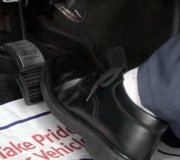This is not a power booster or vacuum problem. That entire system simply makes the brake pedal easier to push. If the vacuum supply is missing or the booster isn't working, the brake pedal will be hard to push and feel the same as when you push it multiple times with the engine not running. The brake systems on all cars are designed to operate sufficiently to bring the vehicle to a safe stop if the engine stalls. To test the booster, right after running the engine, turn it off, then apply the brake pedal multiple times. You should get a minimum of two power-assisted pedal applications, (three or four is not uncommon), then the pedal will become much harder to push. One exception to this is when you have anti-lock brakes, and that system also supplies the power assist. For example, my 1993 Dynasty has the Bendix-10 system that uses an accumulator to store brake fluid at up to 2200 psi. With that system, you get unlimited power assisted stops as long as the ignition switch is on, even if the engine has stalled, and around 40 pedal applications once the ignition switch is turned off.
When you have a low brake pedal, there has to be air in the system or a fluid leak. The fluid leak can be internal or external. An internal leak is due to a ripped lip seal inside the master cylinder. When you press the brake pedal, fluid bypasses that seal instead of being pushed under pressure down to the wheels. The clue is you will not be losing brake fluid from the reservoir. The level will go down if there is an external leak. Those are found by looking for the wet area, and following it back to the source. Slow leaks are commonly caused by leaking rear wheel cylinders if you have rear drum brakes. Rusted steel lines leak faster and will leave a puddle on the ground right under the leak. The fastest leaks are caused by ruptured rubber flex hoses. Those almost always go from no leak to a low brake pedal instantly with no warning.
Remember too that since the late 1960's, all vehicles have their brake systems split hydraulically into two parts, so even if a major leak occurs suddenly, you will still have half the brakes, but the brake pedal will be lower than normal, and the red "Brake" warning light will be on.
If your van has anti-lock brakes and air got into the system, it will usually be necessary to use a scanner to bleed that air out. If you try to bleed at the wheels, you'll force the air to travel through the system and it will get trapped in the ABS hydraulic controller. The scanners have a procedure that commands the ABS Computer to open two valves to let the air be expelled from two chambers, then it can be bled out at two of the wheels.
Bleeding at the wheels is not necessary when replacing the master cylinder as long as the new one is properly bench-bled before it is installed. When you replaced it, was that a rebuilt unit from an auto parts store, or a used one from a salvage yard?
There is one more thing that can cause a low brake pedal if you have rear drum brakes. That is brake shoes that are badly out of adjustment. The first clue is the low pedal comes on gradually, as in over a period of many months. The second, and bigger clue is you'll get a higher and harder brake pedal if you pump it one or two times first before holding steady pressure on it. With each pump the shoes get pushed out closer to the drums, but return spring tension retracts them so slowly that they are still part-way out when you press the brake pedal again. Each time you press the brake pedal, the shoes get closer to the drums, until they make contact, then pedal pressure will feel normal. When you release the pedal and wait a good four or five seconds, the shoes will have time to fully retract, then on the next application, the brake pedal will be low and mushy again.
Also take a look at this article related to a low brake pedal:
https://www.2carpros.com/articles/brake-pedal-goes-to-the-floor
Don't overlook the work that was done on the front caliper mount. If the guide pins are not holding the caliper square to the rotor, excessive piston travel to get the pads to contact the rotor can result in excessive brake pedal travel. This is a variable we can only talk about in general terms until we actually see what is happening. Watch how much movement is taking place when a helper presses the brake pedal. When the brakes are applied, those caliper pistons only come out, then retract, a few thousandths of an inch. Not much more than the thickness of a few sheets of paper.
Monday, September 7th, 2020 AT 4:54 PM



